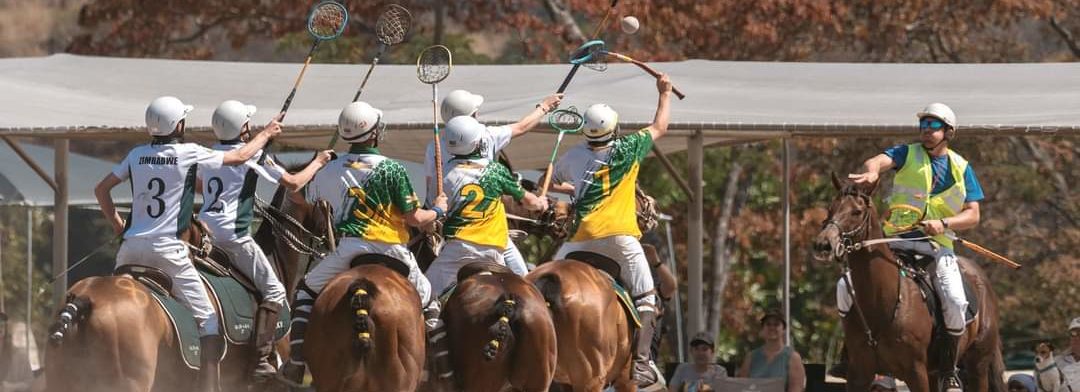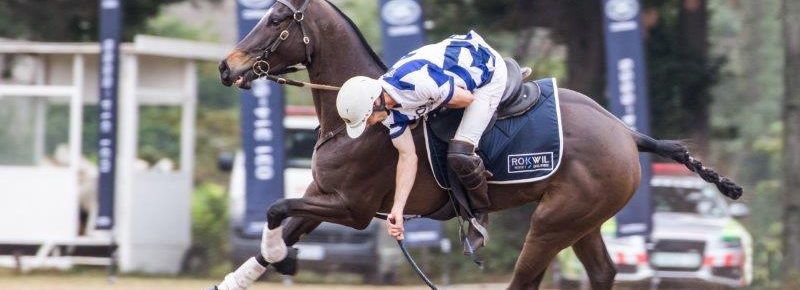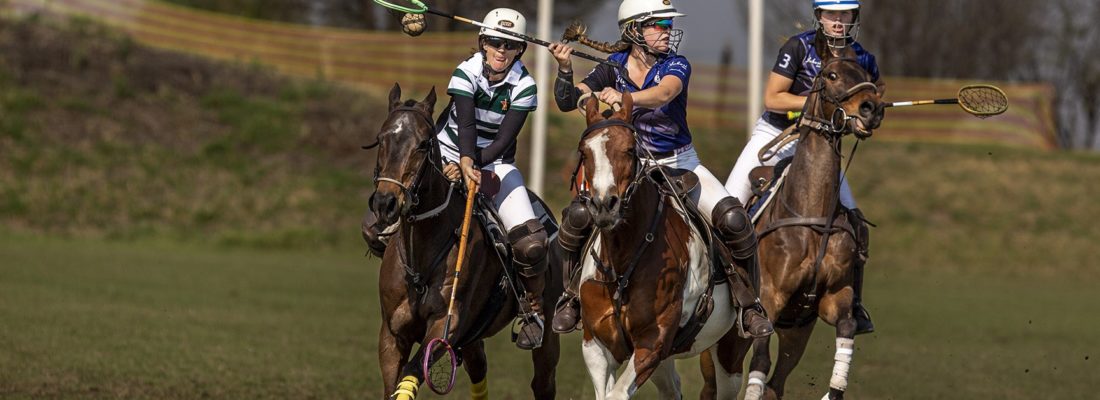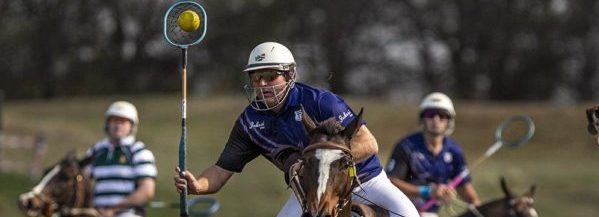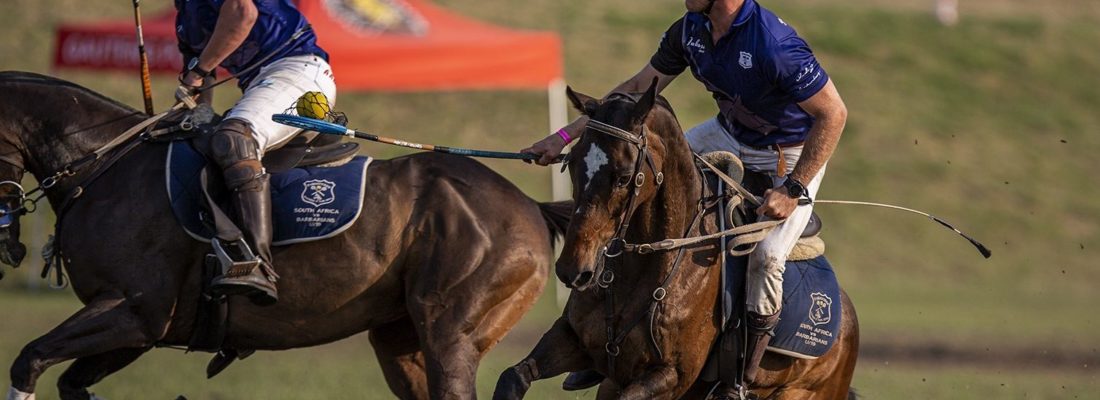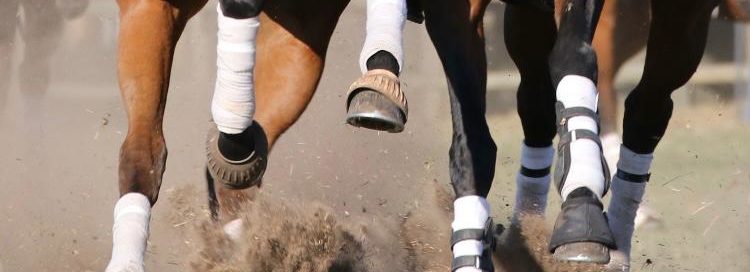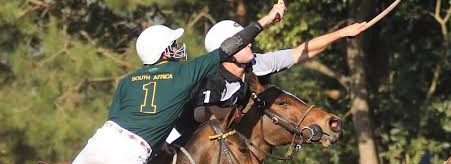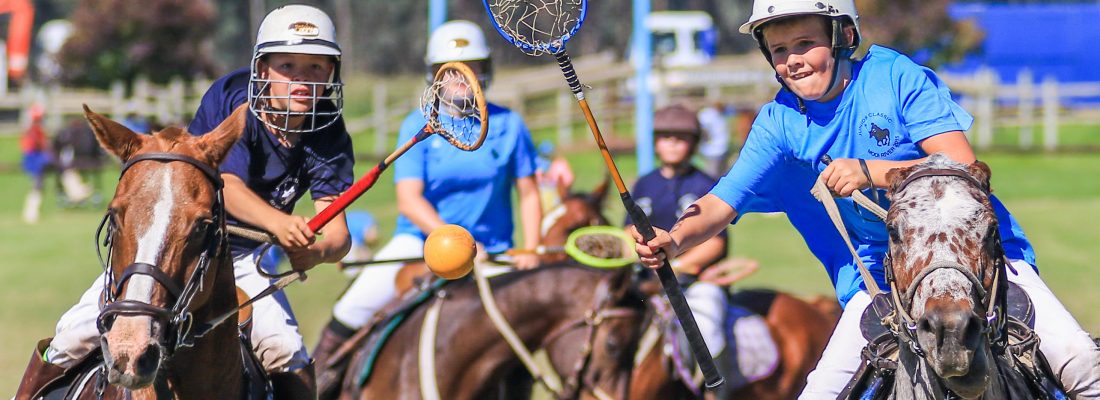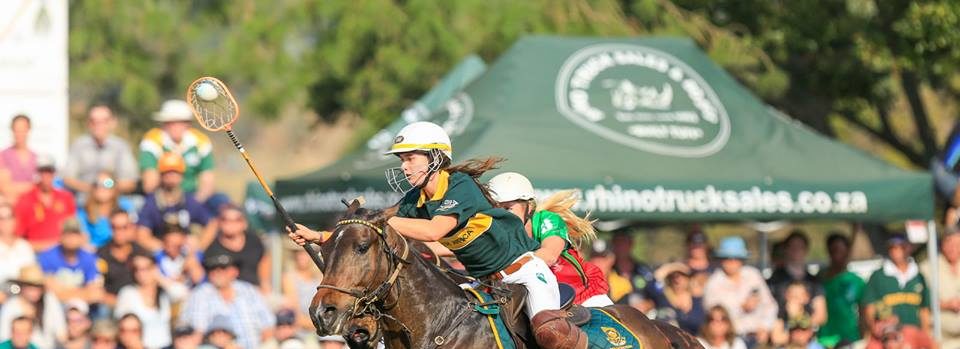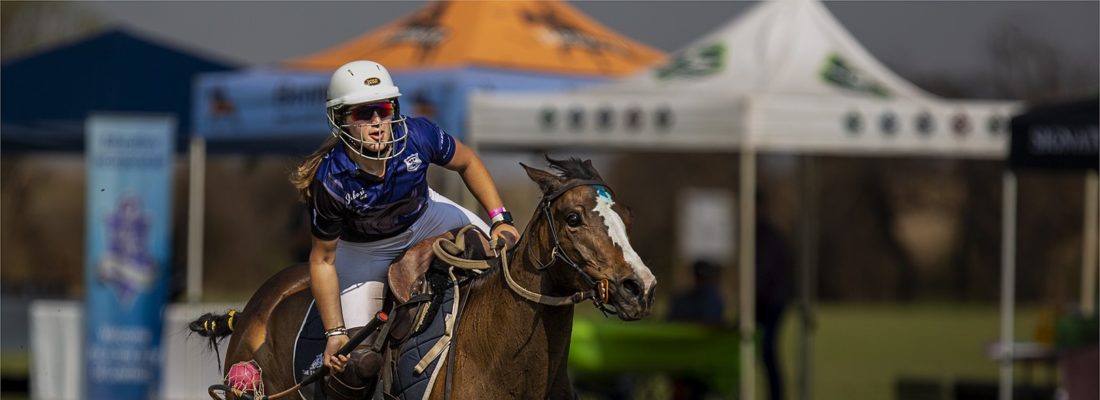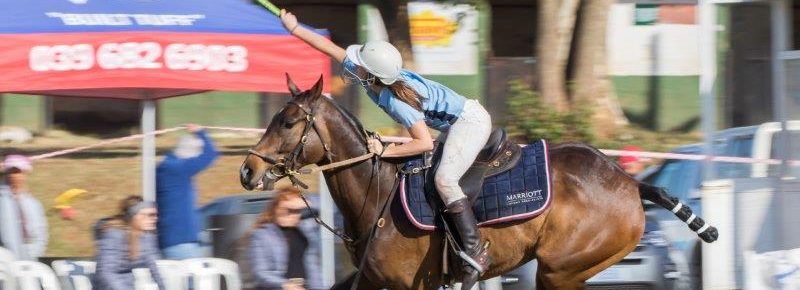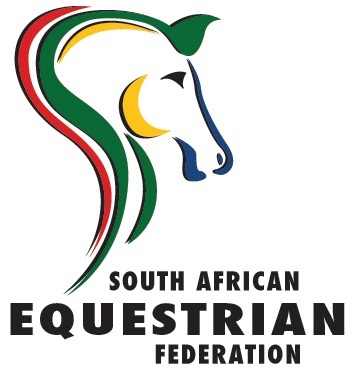Polocrosse Pony Fitness
The Polocrosse Horse – by Susan H. Johnson DVM
The goal of fitness with any athlete is to prepare the athlete for competition in such a manner that the athlete will perform well and without injury. In Polocrosse, the equine athlete will reach our fitness goal if he is able to perform well and last through a hard weekend of competition, without injury. Injuries are the most common consequences to lack of fitness in humans, but with an unfit horse the most notable consequence is lack of performance. Unfit horses do get injured as well, but since muscle soreness and soft tissue pain are often difficult to detect by horse owners, fatigue is the most obvious sign of lack of fitness. When injuries do occur, the horse usually suffers soft tissue damage to the ligaments and tendons of the long, fragile legs, resulting in lameness and eliminating the horse from the competition. A horse that is truly fit for intense competition (Test Match) stands the best chance of staying healthy, sound and strong throughout the event.
Fatigue
A fatigued polocrosse horse can create a very dangerous situation on the polocrosse field. The tired horse is more likely to fall, trip, stumble or run into other horses/players. Sometimes the only sign of fatigue in the horse is the increasing difficulty in stopping him. A severely tired horse will demonstrate less subtle signs of fatigue (head dropping, intense respiration rate, trembling)
The very large muscle mass of the horse and its unique physiology make the horse an ideal athlete for endurance sports. However, when these large muscles groups are required to expend energy beyond the ability of aerobic metabolism, they derive energy from their storage of glycogen; when glycogen is used, lactic acid is produced in excessive amounts (anaerobic metabolism) and this produces muscle fatigue and lack of performance. The performance will be affected the following day as well, with the presence of sore, stiff muscles and the inability to perform at peak levels. A fit horse will be able to stay in aerobic metabolism during exercise, prolonging the lactic acid build up from anaerobic metabolism; his lungs and heart will exchange oxygen more efficiently and allow for longer, stronger intervals of performance. The unfit horse will fatigue faster and end up sore before the weekend is finished, because it simply cannot efficiently provide energy for the large unfit muscles.
Injury
Soft tissue injury to tendons and ligaments in the lower limbs is a common result of overstressing the unfit horse. Bone injury can also occur (bucked shins, splints, fractures) but as the horse gains fitness, the chance of bone injury lessens considerably. Soft tissue strength and integrity will be achieved with careful, consistent exercise.
Fitness
There are several means by which to measure fitness. The most reliable ones are respirations rate and heart rate taken at rest, after warm down and then again after recovery. The recovery period is the time is takes for the horse’s respiration and heart rates to return to resting values. A fit horse will demonstrate a much faster recovery period than an unfit horse. Another element to monitor
would be the amount of sweating produced after exercise. However, since environmental conditions will vary with season and location (humidity and temperature) it will require a certain amount of common sense to determine whether the amount of sweat produced is being influenced by these factors. For instance a young thoroughbred living in Colorado might be sweating very little after a decent workout in July, while an older quarter horse living Houston might be drenched after a 15 min trot session on a hot July morning. The most obvious factors that will influence your horse’s fitness program are the following: –
Heat/Humidity
Cold
Season (Length of coat)
Terrain (hills vs flat)
Breed
Body Conditioning Score (Lean vs fat)
Since these factors can vary so greatly from horse to horse, it would make sense to place the most emphasis on heart rate and respiration rate and especially the recovery time and then take into consideration the amount of sweating.
Monitoring Fitness
When you start the fitness program, it is important to know the resting respiration and hear rates of the horse. You will compare the resting rates with the rates you get after the warm down period and then you will determine the length of time it takes for the horse to return to the resting rates; this is called the recovery time. The average resting respiration rate is 8-16 breaths per minute (rpm) and the average resting heart rate is 36-50 beats per minute (bpm). The respirations or breaths can be counted by watching the nostrils and counting how many times the nostrils flare in a 15 second time period. Multiply this number by 4 and that will tell you the respirations per minute. The heart rate can be counted by feeling the pulse of the facial artery under the rim of the horse’s lower jaw, using two fingers. Again, count the pulse for 15 seconds and multiply that number by 4 to get the beats per minute.
Heat and Humidity
Since humidity and heat can have such an effect on respiration and sweating, it is recommended that the horse be worked in the least humid time of day, which might be early morning in some regions. If a workout must take place in the humid evening hours, the horse should be rinsed with water and scraped with a sweat scraper PRIOR to the workout. After the workout, the horse should be rinsed and scraped as many times as needed until the skin is cool. You might also rinse with a dilute alcohol rinse (one cup rubbing alcohol to one bucket of water) if necessary. The alcohol helps to evaporate the moisture faster in really humid environments. Placing the horse in front of a fan until the coat dries is also recommended. Some drinking-water sources are prone to getting hot in the summer, so having a cool bucket ready for after the workout is an important consideration.
Cold
In colder regions, horses can be worked successfully at any time during the day that does not unnecessarily expose them to moisture or wind. It is recommended that the horse be cooled down briefly (less than 5 minutes) before being covered with a wool or synthetic “cooler”. This helps prevent chilling, which can lead to inadequate water consumption and possible colic. Once the coat is dry, the cooler is removed the coat is brushed or fluffed to help retain the heat. A common problem for horses being worked in colder environments is an inadequate water intake. It is important to allow access to fresh, thawed water sources at all times. Some people “salt the feed” to increase the thirst.
Season
The coat length will vary with management, but if the horse has been clipped of his thick winter coat, he will gain fitness faster and more efficiently. It is important to keep these horses blanketed in the late winter/early spring to keep the coat short and then keep in mind that the horse may need to wear a cooler after workouts to prevent chilling. If the horse has a significant winter coat, it is important to rinse or brush out the sweat in the coat so this it is fluffed and able to retain heat when the horse is turned back out. AS the weather warms, it is very important that the coat be thinned regularly with a shedding blade to lift and remove the shedding winter coat. The sooner the horse sheds the winter coat, the faster the fitness will be achieved.
Terrain
Ideally, the polocrosse horse would be cross-trained, with a variety of hills and flat fields. Running up an incline can build hind end musculature but controlled work on the flat produces significant fitness results, as far as endurance is concerned.
Age
The age of the horse does not necessarily change the fitness program, as long as the horse is sound, healthy and careful monitoring of fitness is conducted.
Breed
The variability within breeds of horses prevents us from tailoring fitness programs to certain breeds, but the breed shouldn’t necessarily change the fitness program, as long as careful monitoring of fitness is conducted.
Body Condition Score (lean vs fat)
Very few overweight horses can compete with the lean horse, assuming fitness is equal, so it is critical that the polocrosse athlete be spared the misery of competing while carrying excess fat. However, again, the BCS of the horse does not change the fitness program as long as the same careful monitoring of fitness is conducted.
THE BOTTOM LINE…
Common sense plays a very important role in the horse’s fitness program. It may take one horse 4 weeks of trotting and weekend practice to become tournament-fit, while an older heavy quarter horse in Texas may take 8 weeks of daily workouts to get ready for competitive play. The best and only reliable way to measure the horse’s fitness progress is to very closely monitor the horse’s recovery time after each workout.
The Fitness Schedule
The 8 week fitness schedule is a guide for bringing a horse up to peak fitness. The schedule is geared toward the first of the polocrosse season. Some horses may take small breaks in the season and only require 3-4 weeks or less to regain fitness for the next event. As the recovery rates are monitored, each work out would be tailored to reach the fitness goal. For instance, if the horse seemed to fatigue after 10 minutes of cantering, he should be slowed to a trot for the remainder of the workout. Alternatively, if the recovery time was fairly short (5 minutes), the next workout could be lengthened or increased in intensity. You might consider lengthening each workout by 3-5 minutes if your horse is recovering well (10-15 minutes) and demonstrating heart rates and respiration rates in a range of 100/40, respectively, during the warm down period.
Warm Up/Warm Down
It is imperative that the horse be warmed up prior to each workout and then be warmed down for 10 minutes. The warm up period may only last five minutes and involve lunging or trotting, with or without flexing. The warm down period should involve light exercise (easy trot/fast walk) for a minimum of 5-10 minutes to allow time for the blood to remove lactic acid and prevent soreness.
Week 1 and 2
In the first two weeks, the horse is started conservatively, with 15-20 minutes of trotting/cantering four times a week. The work out is at slower speeds for longer distances. This type of exercise (trotting/cantering) should keep the horse in aerobic metabolism and keep his heart rate lower 150 bpm. This is critical time to determine the horse’s existing fitness level by measuring his heart rate and respiration rate both before exercise and after the warm down period. As he becomes more fit, the recovery period will become shorter. This initial two week period is also the time to be grooming with the shedding blade or clipping the horse of his winter coat. If it is in the summer, this is the week to be sure to have cooling measures ready for adequate recovery and cool down.
Week 3 and 4
In the following two weeks, the schedule allows for longer intervals of aerobic training and assume that some polocrosse activity (practice, stick/ball work) will take place at least once a week. If no practice is scheduled, it would be best to work the horse for 30-60 minutes once a week, in polocrosse fashion (ball and stick work), allowing for adequate breaks in the workout.
Week 5
In week five, the schedule shifts to prepare for more competitive activity on the weekends (2- day practice or tournament). This is the time to add faster sprint workout during the week, with small periods of rest (trotting) between each sprint. The goal is to prepare the large muscle groups of the horse for not just long distance/endurance work but also for shorter, more intense work, as the game would require. The horse may not be truly fit for his fifth weekend, so check the calendar and be sure to plan ahead for a lower key weekend of polocrosse.
Week 6,7 and 8
In week six, seven and eight, the horse is gaining fitness rapidly and by the eighth weekend, should be at peak fitness. Peak fitness is where all horses must be for test match competition. It is very important to acknowledge the “Rest” days on the schedule. The damage done on soft tissue after a weekend of polocrosse needs time to repair. The Friday’s before the last few weekends are very important days in the schedule where the horse must be trotted/cantered for at least 15 minutes in preparation for a hard weekend of polocrosse. Longer, more strenuous workouts are not recommended on the days before a tournament.
IN CONCLUSION….
Programs for any athlete should not be limited to exercise without consideration for other very important factors – Nutrition, electrolytes, deworming, dental health, sound feet, proper fitting of tack and the training level are all factors that need to play a role in the horse’s fitness program. Aerobic conditioning and sprint-work are imperative to building the strength and stamina for polocrosse and we owe it to our horses to have them fit for this sport.
